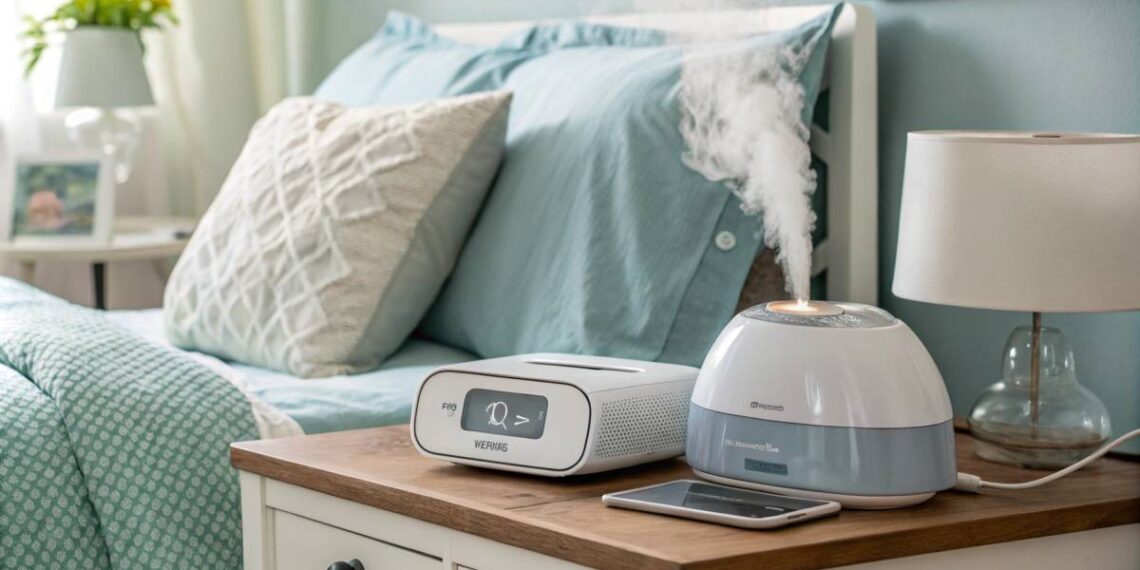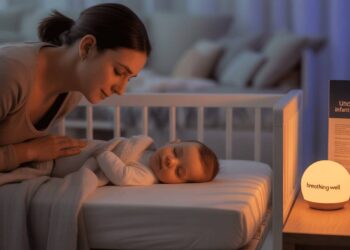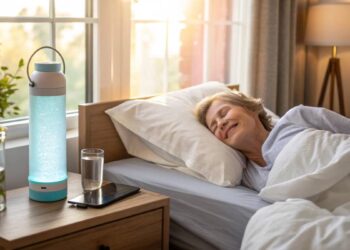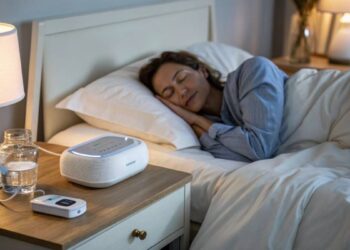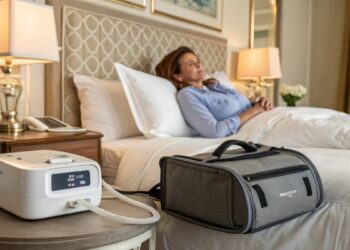Struggling to achieve restful nights despite CPAP therapy? You’re not alone. Enter CPAP humidifiers—the game-changers that transform your sleep experience by adding much-needed moisture to the air you breathe. Imagine waking up refreshed without the irritation of dry mouth or sore throat. Whether you’re new to CPAP or seeking to enhance your current setup, understanding the right humidifier can make all the difference. Dive into our guide to discover how top-rated CPAP humidifiers can elevate your sleep quality, ensuring every night is as peaceful as a lullaby.
Key Takeaways
- Role of Humidifiers in CPAP Therapy: CPAP humidifiers add moisture to prevent dryness and irritation, enhancing therapy comfort.
- Benefits of Using a CPAP Humidifier: Reduces dryness, alleviates irritation, promotes better sleep quality, and increases therapy compliance.
- Factors to Consider When Choosing a CPAP Humidifier: Adjustable humidity levels, size and compatibility with your CPAP machine, noise level, water chamber capacity, and ease of cleaning.
- Types of CPAP Humidifiers: Integrated, standalone, and heated humidifiers each offer unique advantages for different user needs.
- Tips for Using CPAP Humidifiers Effectively: Proper humidity settings, regular cleaning and maintenance, and optimal positioning of the humidifier.
Understanding Sleep Apnea
Sleep apnea is a sneaky sleep troublemaker that strikes when you’re least aware—right in the middle of your dreams. It’s especially common for folks who may carry a little extra weight or who’ve been around the sun over 40 times. Knowing about sleep apnea is crucial if you want to tackle it head-on and get treated right.
What is Sleep Apnea?
Imagine snuggling into bed for some sweet slumber, only to have your breathing hit the “pause” button. These pauses, ranging from a few heartbeats to a minute, keep popping up all night long. There are a few main types:
| Type | Description |
|---|---|
| Obstructive Sleep Apnea (OSA) | This one’s about clutter in your throat—extra tissue making it hard to breathe. |
| Central Sleep Apnea (CSA) | Here, it’s like the brain left the “Breathe!” memo at home and doesn’t remind your body to keep going. |
| Complex Sleep Apnea Syndrome | A mash-up of both obstructive and central types that keeps things interesting. |
For the lowdown on these variations, take a peek at our article on central vs obstructive sleep apnea.
Common Symptoms and Risks
Folks with sleep apnea often deal with some annoying symptoms. Here’re the usual suspects:
| Symptom | Description |
|---|---|
| Loud Snoring | If sawing logs were an Olympic sport, they’d take the gold! |
| Gasping or Choking | Sit up suddenly, gasping for air – not a fun way to wake up! |
| Daytime Fatigue | Feels like you took a nap uphill – you’re tired all day. |
| Morning Headaches | Wake up feeling like a drummer had a jam session on your head. |
These problems can lead to more serious stuff, like heart races, high blood pressure, and even dozing at your desk (or worse, behind the wheel!). More on what this could mean for your ticker in our article on sleep apnea heart problems.
Why Treatment Matters
Dealing with sleep apnea is a must if you want to stay healthy and happy. Leaving it be can spiral into bigger issues, such as:
| Complication | Description |
|---|---|
| Cardiovascular Issues | Got your heart playing unwanted acrobatics, like high blood pressure and stroke risk. |
| Diabetes | Upping your chances of messing with insulin and tackling type 2 diabetes. |
| Relationship Strain | Your partner loses sleep too, leading to the start of “World Snoring Wars.” |
Using treatments like CPAP therapy can make bedtime a peaceful event and keep those pesky complications at bay. And if CPAP ain’t your cup of tea, we’ve got options galore in our article on alternatives to CPAP. Figuring out what’s going on and getting help leads to better z’s and brighter days. Taking a home sleep apnea test could be just the ticket to solving your sleep woes and getting you back on track.
CPAP Humidifiers Explained
Role of Humidifiers in CPAP Therapy
CPAP humidifiers are like the unsung heroes for those using Continuous Positive Airway Pressure (CPAP) therapy. These neat gadgets add a splash of moisture to the air from the CPAP machine, which keeps folks from feeling like they’re sleeping in a desert. If you’re one of those dealing with sleep apnea, you know that constant air-flow can be irritating as all get out. Tossing a humidifier into the mix can seriously dial down the discomfort, making therapy bearable and encouraging you to stick with the program. It’s a win-win!
“A good night’s sleep is a cornerstone of true health.” – Thomas Dekker
Bringing in a bit of humid air doesn’t just make things comfy—it can even prevent pesky side effects, like nose stuffiness and sore throats, that a lot of users gripe about. By turning a potentially unpleasant experience into something smooth and breezy, CPAP humidifiers help folks keep up with their therapy, making it easier to follow through with the treatment plan.
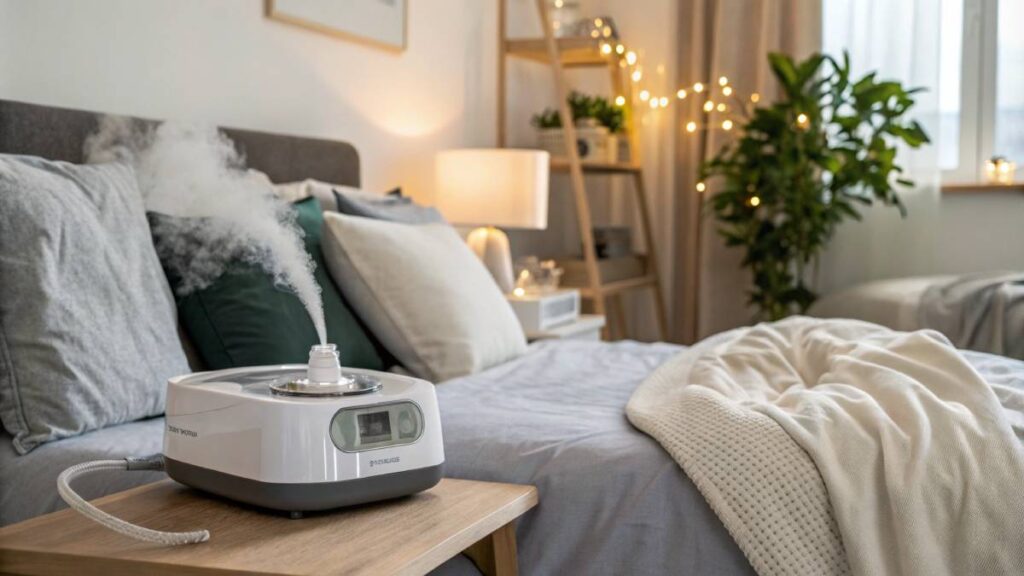
Benefits of Using a CPAP Humidifier
Throwing a humidifier into your CPAP setup can make a world of difference when it comes to getting some quality shut-eye. Check out these perks:
| Benefit | Description |
|---|---|
| Goodbye Dryness | Humidifiers sprinkle some much-needed moisture into the mix, putting an end to those dry mouth and throat woes CPAP users know too well. |
| Bye-Bye Irritation | Extra humidity means less annoyance in your throat and nasal passages, so you can snooze more peacefully. |
| Sleep Boost | Being comfy can lead to catching some deep Z’s, cutting down on those annoying wake-ups during the night. |
| Steady Use | When discomfort decreases, people are more inclined to stick with CPAP therapy, ultimately scoring better health outcomes. |
For those battling sleep apnea, especially those dealing with dryness issues, a CPAP humidifier could be just what the doctor ordered. Hitting the sweet spot with humidity levels can turn using a CPAP machine from meh to mighty effective therapy. If you’re curious about other sleep apnea complications, you can check out topics on what causes sleep apnea or the connection between sleep apnea and heart troubles.
“Health is not valued until sickness comes.” – Thomas Fuller
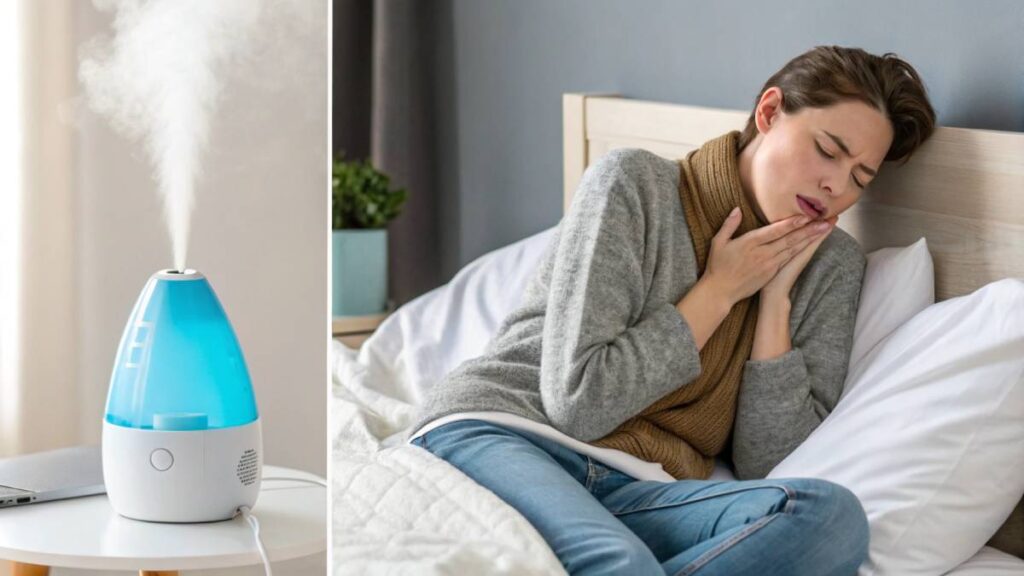
Factors to Consider When Choosing a CPAP Humidifier
Picking the right CPAP humidifier can make a world of difference in how comfy and effective your sleep therapy can be. Let’s dig into what you should really think about to ensure your experience is top-notch.
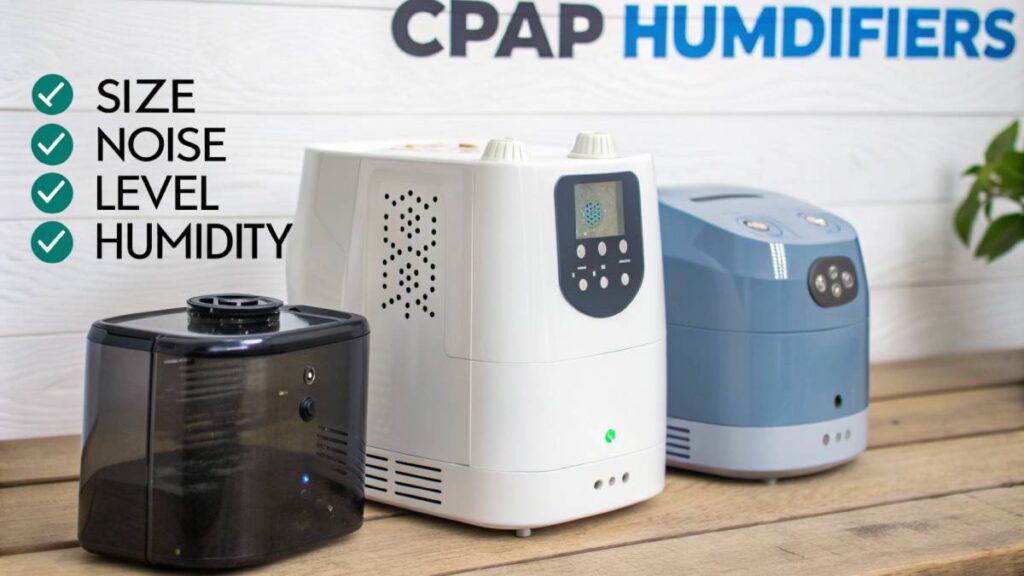
Adjustable Humidity Levels
Adjustable humidity is a biggie. Everyone’s got their own sweet spot when it comes to how steamy or dry they like things. With adjustable settings, you can tweak it to fit like a glove. Go too low, and you’re waking up with a throat like the Sahara. Crank it too high, and you might be dealing with a soggy mask situation. Aim for something that lets you adjust those levels ‘til it’s just right.
| Humidity Level | Description |
|---|---|
| Low | Might make your nose and throat feel parched |
| Medium | Goldilocks zone for most folks |
| High | Handy when things are extra dry around ya |
Size and Compatibility
Space isn’t always on our side, so think about the size. A pint-sized humidifier is tidy and perfect if you’re short on room. Bigger ones hold more water, so they’re not so thirsty for refills. Make sure it’ll actually fit your CPAP, though. You don’t want to end up with a humidifier that doesn’t match with your setup. Peep the specs before buying.
| Humidifier Type | Size | Compatibility |
|---|---|---|
| Integrated | Little buddy | Built for certain CPAP models |
| Standalone | Medium to hefty | Plays nice with multiple machines |
| Heated | Can vary | Some are picky about which CPAPs they’ll hang with |
Noise Level
Noise can be a real sleep killer. If you’re the type that counts every little decibel, you’ll wanna find one that whispers in the night. This matters even more if someone shares your bed. A busy hum can bug them more than a snoring dog.
| Noise Level | Description |
|---|---|
| Silent | Sleeps like a baby |
| Low | Hardly notice it’s there |
| Moderate to High | Could be a snooze-disturber |
Getting yourself the right CPAP humidifier is key to feeling comfy and sticking with your therapy. If you’re curious to learn more about catching good z’s, check out our other reads on sleep apnea symptoms and some chill natural sleep apnea remedies.
Types of CPAP Humidifiers
Choosing the right CPAP humidifier can make a huge difference in how well you sleep. There’s a variety of types out there, each with its own perks to make your CPAP experience a lot cozier. Let’s dive into the main types of CPAP humidifiers and what makes them tick:
Integrated Humidifiers
Integrated humidifiers come built into CPAP machines, which makes them easy peasy to handle. Everything’s combined into one neat package, so you don’t have to fuss with extra parts. People love this type for being straight-up simple and hassle-free.
These little guys are pretty smart too; they often tweak the humidity on their own, based on what you set and the room conditions. This means you’re comfy no matter how you sleep.
| Feature | What’s it do? |
|---|---|
| Saves space | Packs in with the CPAP machine |
| Auto humidity | Adjusts automatically for user comfort |
| Easy setup | No-brainer to set up and keep clean |
Standalone Humidifiers
If you crave flexibility, standalone humidifiers might be your jam. They aren’t part of any one machine, so you can mix and match with different CPAPs. You get to play around with humidity levels and decide on how big a tank you’ll need.
Generally, these come with bigger water containers, which means fewer trips to refill. That’s a bonus if you snooze for long hours.
| Feature | What’s it do? |
|---|---|
| Flexibility galore | Works with multiple CPAP devices |
| Bigger tank | More water, fewer fill-ups |
| Custom settings | Manual tweaks for perfect humidity |
Heated Humidifiers
Heated humidifiers take it up a notch by warming up the water before it hits the air. This gives you a comforting flow of warm and moist air, tackling pesky dryness or irritation.
You can adjust the heat to nail your perfect comfort zone. Plus, they help keep your CPAP tubing nice and dry by cutting down on condensation.
| Feature | What’s it do? |
|---|---|
| Toasty air | Keeps you comfy and dry |
| Heat control | Adjusts warmth to fit your liking |
| Busts condensation | Keeps tubing free from pesky moisture |
Figuring out which CPAP humidifier suits you best can really boost your treatment game. By checking out all the features, you get to make your CPAP therapy a lot more comfortable and improve your zzz’s. For more on sleep apnea, swing by our pages on sleep apnea symptoms and what causes sleep apnea.
Features to Look for in a CPAP Humidifier
Choosing a CPAP humidifier is like picking the perfect pillow—it makes all the difference for restful sleep. Let’s break down what to look for when you’re in the market for one.
Water Chamber Capacity
The heart of a humidifier’s operation. Bigger tanks mean fewer midnight top-ups, which is gold for folks who like their sleep uninterrupted. If you love to snooze, aim for a humidifier that can go the distance.
| Water Chamber Capacity | Hours It Lasts |
|---|---|
| 250 ml | 6-8 hours |
| 400 ml | 8-10 hours |
| 600 ml | 10-12 hours |
Picking a unit with enough capacity helps keep your throat from feeling like a desert and reduces those morning crankies.
Easy Cleaning and Maintenance
Nobody enjoys deep cleaning gadgets. Find a humidifier that’s user-friendly when it comes to scrubbing. Designs that easily come apart are a win, and if they can go in the dishwasher, you’ve hit the jackpot.
Consider the following when maintaining your gadget:
| Feature | Why It Matters |
|---|---|
| Dishwasher-safe bits | Makes life easier |
| Smooth surfaces | Keeps icky stuff at bay |
| Clear instructions | No guesswork involved |
Want the down-low on cleaning? Check out our guide on how to clean cpap machine.
Warm-Up Time
Warm-up time affects how fast you can whisper sweet dreams to your pillow. Some get the air mellow in no time, which is a blessing if you’re not in the mood to wait.
| Warm-Up Time | Speed Rating |
|---|---|
| 1-3 minutes | Lightning |
| 4-6 minutes | Average |
| Over 6 minutes | Take-your-time |
Fast warm-up times can make the whole CPAP shebang smoother and less fuss, especially if you’re just getting into the swing of things.
By thinking about these essentials—how much water it holds, ease of cleaning, and warm-up speed—you’ll snag a humidifier that fits your lifestyle like a glove. Sweet dreams, folks! For more bedtime tips, check our piece on sleep apnea symptoms.
Improving Sleep with CPAP Humidifiers
When it comes to catching some Z’s for folks dealing with sleep apnea, CPAP humidifiers can be a game changer. Here’s the lowdown on how these devices help you sleep like a baby.
Enhanced Comfort and Compliance
Imagine this: nice, moist air circling around you as you snooze. That’s what a CPAP humidifier does. By keeping your throat and nose from getting dry, it turns snoring into smooth sailing. And if it’s comfy, you’re more likely to stick with your CPAP therapy, which is a win-win.
| Compliance Benefits | What’s the Deal? |
|---|---|
| Bye-bye discomfort | Moist air keeps dryness and irritation at bay. |
| More mask time | Comfy users are the happy, consistent users. |
Alleviating Dryness and Irritation
Nobody likes waking up with a sore throat or stuffy nose. Enter the CPAP humidifier! By keeping the air just right, it can help you dodge those pesky irritations, making the whole breathing business a lot easier. It’s perfect for folks who struggle with respiratory stuffiness or who find traditional CPAPs a pain in the, well, nose.
| Irritation Relief | Reason to Smile |
|---|---|
| Breezy nasal passages | Moisture says bye to blockages. |
| Throat’s best buddy | No more scratchy wake-ups. |
Promoting Better Sleep Quality
With a comfy nose and throat, drifting into dreamland is easier. CPAP humidifiers are the secret trick for deeper, more refreshing sleep. With no dry air to bother you, you might just wake up feeling like you’ve conquered the world. Studies show those moisture-infused nights can really improve your sleep patterns, a real boon for sleep apnea sufferers.
| Sleep Quality Perks | What’s in it for Me? |
|---|---|
| Zzzs for success | Fewer wake-ups, happier dreams. |
| Morning magic | Good sleep = a focused, energized you all day. |
Adding a humidifier to your CPAP therapy routine can feel like hitting the sleep jackpot if you’re battling sleep apnea. The cozy comfort not only helps you stick with it but gives your whole well-being a boost. Got more questions about sleep apnea? Check out our article on sleep apnea symptoms.
Tips for Using CPAP Humidifiers Effectively
Using a CPAP humidifier can make the whole sleep apnea thing a lot more agreeable. Here are some handy tips to make the most out of it.
Proper Humidity Settings
Nailing the right humidity level is all about comfort. Most CPAP gadgets let you tweak the humidity settings, so you get the right moisture in the air while you’re catching z’s. The best setting? It depends on what feels good for you and what the weather’s doing outside.
| Humidity Level | Where It Works Best |
|---|---|
| Low (1-3) | Hot and sticky weather |
| Medium (4-5) | When you need a little aid against dryness |
| High (6-7) | Cold, dry days |
Try playing around with these settings to see what keeps the sandman kind without leaving you too soggy.
Cleaning and Maintenance Routine
Keeping that humidifier spick and span is key. A clean humidifier wards off mold, germs, and the rest of the yucky stuff that could mess with your breathing.
Sprucing Up Schedule:
| Frequency | What to Do |
|---|---|
| Daily | Dump out water and give the chamber a rinse with warm water. |
| Weekly | Wash the chamber with mild soap and warm water, then rinse well. |
| Monthly | Check and tidy up the humidifier connections and tubing. |
Need more details on sprucing up your CPAP gear? Check out our guide on how to clean a CPAP machine.
Positioning of the Humidifier
Where you put your CPAP humidifier matters for how well it works. Ideally, keep it on the same level as your CPAP machine or a bit lower. This keeps water from backing up into the machine, which could cause it to act up.
- Set the humidifier on a sturdy spot.
- Keep it close to the CPAP machine to avoid long tubing that might mess up airflow.
- Don’t put the humidifier in direct sunlight or near heat sources, as this can mess with the humidity.
Follow these tips to make the most out of your CPAP humidifier, aiming for a good night’s sleep and better sleep apnea control. For more lightbulb moments about managing sleep apnea, have a look at our posts on sleep apnea symptoms and what causes sleep apnea.
Main Tips
- Adjust Humidity Levels: Customize the moisture output to match your comfort needs and environmental conditions.
- Regular Cleaning: Maintain a strict cleaning routine to prevent mold and bacteria buildup in your humidifier.
- Choose the Right Type: Select between integrated, standalone, or heated humidifiers based on your CPAP machine and personal preferences.
- Monitor Water Chamber Capacity: Ensure your humidifier’s water chamber can hold enough water to last through the night without frequent refills.
- Optimal Placement: Position your humidifier properly to avoid water backup and ensure efficient moisture distribution.
Final Thoughts
A CPAP humidifier is more than just an accessory—it’s an essential component that can significantly enhance your sleep therapy experience. By adding moisture to the air, these devices help mitigate the dryness and irritation often associated with CPAP use, making your nightly routine more comfortable and sustainable. As you navigate the various types and features available, remember that choosing the right humidifier tailored to your needs can lead to improved sleep quality and better health outcomes. Regular maintenance and proper use of your CPAP humidifier ensure it continues to serve you well, providing the tranquility necessary for restorative sleep. Embrace the benefits of humidified CPAP therapy and take a confident step towards nights filled with peaceful, uninterrupted rest. Prioritize your sleep health today and wake up revitalized each morning, ready to face the day with vigor and vitality.
Conclusion
Choosing the right CPAP humidifier is essential for transforming your sleep therapy from merely functional to genuinely comfortable. By understanding the various types, benefits, and key features to consider, you can tailor your setup to perfectly match your unique needs. From integrated models offering convenience to heated options providing extra comfort, the right humidifier can mitigate dryness, reduce irritation, and significantly boost your overall sleep quality. Coupled with mindful maintenance and proper settings, a CPAP humidifier not only enhances your nightly rest but also fosters long-term health benefits by improving therapy adherence. Embrace the tranquility that comes with optimized CPAP therapy and wake up to brighter, more energized days. Your journey to better sleep starts with making the right humidifier choice, turning restless nights into peaceful slumbers and paving the way for a healthier, more vibrant you.
FAQs
What are the main benefits of using a CPAP humidifier?
CPAP humidifiers add moisture to the air, reducing dryness and irritation in the nasal passages and throat, leading to more comfortable and effective therapy.
How do I choose the right CPAP humidifier for my needs?
Consider factors like adjustable humidity levels, size and compatibility with your CPAP machine, noise level, water chamber capacity, and ease of cleaning when selecting a humidifier.
What types of CPAP humidifiers are available?
There are three main types: integrated humidifiers built into CPAP machines, standalone humidifiers that can work with various devices, and heated humidifiers that warm the air to prevent condensation.
Can a CPAP humidifier improve my sleep quality?
Yes, by adding moisture to the air, a CPAP humidifier can alleviate dryness, reduce irritation, and enhance overall comfort, leading to better sleep quality and adherence to therapy.
How often should I clean my CPAP humidifier?
It’s recommended to empty and rinse the water chamber daily, wash it with mild soap and warm water weekly, and check for any buildup or mold monthly to maintain hygiene and functionality.

